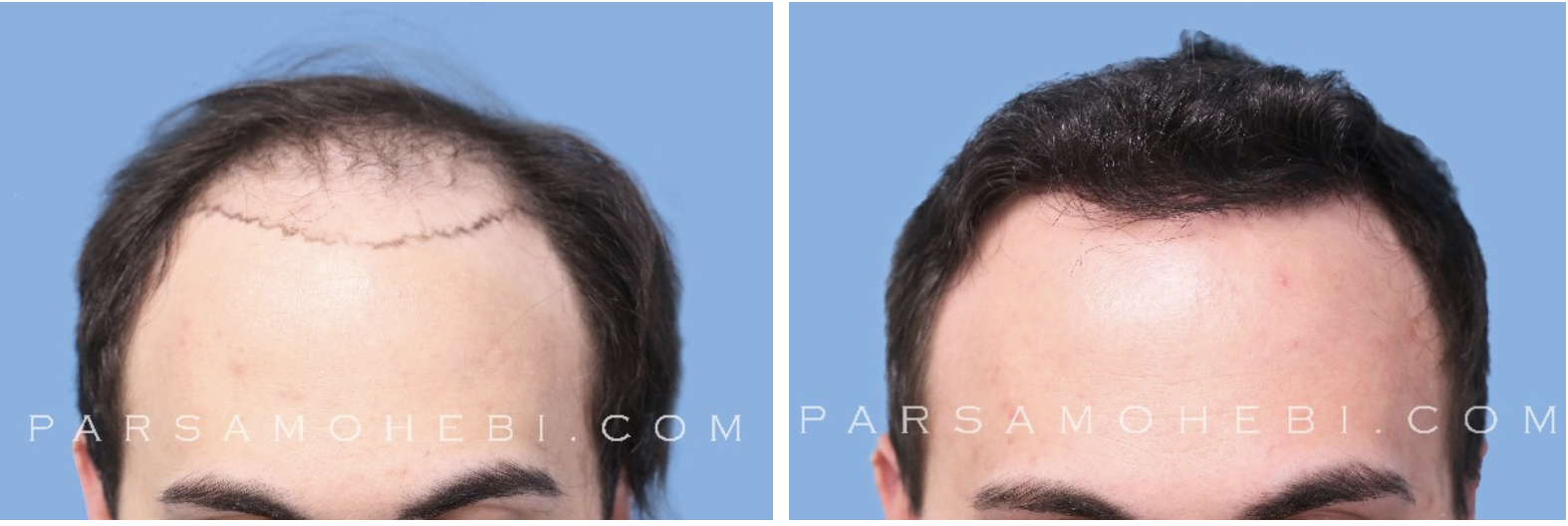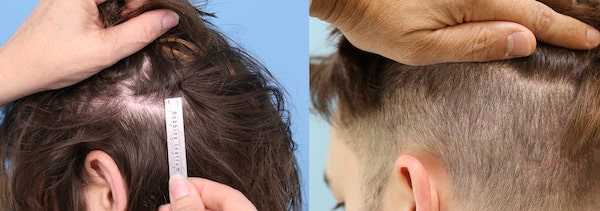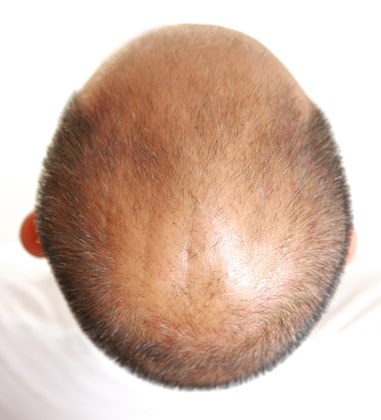Hair Transplant Benefits – Info Revealed
The appearance of hair loss on the scalp can impact the look and self-image of a person. The most successful and long-lasting way to restore hair on the scalp is to undergo a hair transplant. During this procedure, a surgeon takes hair grafts from elsewhere on the body and transplants them into the balding or thinning areas of the scalp. The hair grafts usually come from the donor area on the back and sides of the scalp, but they can also come from the beard or the chest of the patient. Once the hair grafts are placed in the targeted areas on the scalp, the hair will begin to grow and give patients a fuller and thicker head of hair. In addition to a fuller look to the hair on the head, there are additional benefits that can be enjoyed after undergoing a hair transplant.
Hair Transplants Benefits – What Patients Need to Know
One of the first benefits patients will notice is an improvement in the appearance of the hairline on the scalp. In addition to giving a person a fuller head of hair, the appearance of the transplanted hair will not happen overnight which means the hair will grow back at a rate where the final appearance will have a natural look. The fact that the person had a hair transplant will not be able to be detected by the average eye. Thanks to the advancements in hair transplant technology, many patients can enjoy the same look to the scalp and hairline as they had before a balding appearance started to become noticeable on their scalp. In addition, the growth of hair on the scalp will give a patient a feeling of having an improved and rejuvenated look to the scalp.
The amount of confidence felt by a person will also increase thanks to the fuller head of hair. If a person is experiencing balding on the scalp, they will often wear a hat in order to hide the balding areas on the head from the public. Thankfully, a hair transplant technique such as Follicular Unit Extraction (FUE) is able to give the scalp a fuller head of hair by filling in the areas of the scalp that are balding. A healthy and full head of hair can grow the self-confidence of a person and also give a patient a better self-image.

One of the common concerns related to any type of surgical procedure is the possibility of side effects after the surgery. There are some common conditions that occur after a hair transplant, and they include swelling, bruising, and some temporary pinkish discoloration in the treated area of the scalp. These conditions are temporary, and they will resolve on their own and fade as time passes after the surgical procedure. When it comes to hair transplant side effects, there are not really any side effects patients need to worry about following the treatment. If there is any type of sharp or lingering pain in the days immediately after the procedure, this can normally be handled with mild painkillers prescribed by the surgeon.
The main benefits of a hair transplant can best be described as saving patients money and giving them results that last a lifetime. Even though medications such as minoxidil and finasteride can stimulate the growth of hair on the scalp, the results from these hair restoration options are not permanent. Once a person stops using minoxidil or finasteride on a regular basis, the patient will eventually begin to lose the results they have gained on the scalp. Once these results are lost, the original appearance of the hairline will return to the scalp. On the other hand, the results of a hair transplant are permanent which means the patient will enjoy results that last a lifetime.
While a hair transplant might seem like a large investment of money to address the appearance of the hairline, it will actually save money in the long run since the results from the procedure are permanent. The use of minoxidil and finasteride needs to be ongoing to maintain the results which means a person must keep spending money on the product on a regular basis in order to maintain the results. This will need to be part of their monthly budget instead of making a one-time payment for the surgical procedure. Yes, the payment for a hair transplant can be a large expense but this is helpful for the long-term budget as the payment is made and finished. Since the results of a hair transplant last a lifetime, there is no need for monthly payments for medications to maintain the results.
How to Gain the Benefits of a Hair Transplant
Patients who are interested in enjoying the benefits that can be gained for a lifetime from a hair transplant should take the first step of scheduling a consultation appointment with a hair transplant surgeon. An experienced and board-certified hair transplant surgeon will examine the scalp of the patient to determine the reason for the hair loss as well as the best hair transplant technique to address the hair loss. The doctor will also discuss the desired results with the patient and set realistic expectations so the person will have a better idea of the type of results they will enjoy after the surgery.
Hair Loss to Hide a Scar – How Does it Work?
If a person experiences some type of trauma or accident to the scalp, the result might include the appearance of a scar on the scalp. It is obvious to say that no one wants to have a visible scar on their scalp. Thankfully, there is a chance for the scar to be hidden from view if the patient has a hair transplant.
Curious about how a hair transplant is able to conceal the appearance of a scar? Keep reading to learn how a hair transplant can address a scar on the scalp and the type of results that can be expected from the procedure.

Hair Transplant – What Happens with the Scar Tissue
Once a scar starts to form on the scalp of a person, their hair will not be able to grow naturally in the area of the scar because there are not any hair follicles located in the scar. In general, hair follicles are capsules located under the skin. In addition, the blood vessels that are located under the follicles help them grow. This process is interrupted if a scar forms on skin that is damaged by an accident or trauma as the hair follicles are not able grow back. Keep in mind that scars are composed of collagen that forms to the protect the skin that is under it. In other words, there is normally not any available space for hair follicles in the scar which means a traditional hair transplant is not able to place hair into the follicles that currently exist.
Instead, the surgeon will have to transplant hair grafts still contained in their follicles into the scar. This step allows the hair grafts to begin to take root, so they start to grow again thanks to them coming into contact with the blood vessels. Once the impacted area has healed and the hair follicles have taken hold in the skin to the point they are getting a flow of blood from nearby blood vessels, the hair follicles will begin to grow back.
There is also another treatment option if the scar tissue is raised and thick. In this case, the doctor might recommend that the patient receive corticosteroid injections around the scar, so the surface flattens in the area being treated which helps it gain a more natural appearance.
Hair Transplant to Help Hide a Scar – How it is Performed
The surgeon can perform Follicular Unit Extraction (FUE) hair transplant surgery which means the doctor will remove hair follicles on an individual basis from the donor area on the scalp. The hair follicles are usually taken from the sides or back of the scalp because these areas of the scalp are generally resistant to balding. The individually removed hair follicles are placed into openings that the surgeon creates in the scar tissue.
During the first few days after the surgery, the patient might need some pain medication to help control any pain or discomfort at the start of the recovery period. The patient might also need to take antibiotics in order to reduce the chance of an infection occurring after the surgery. There might also be a need for steroids, or other anti-inflammatory medications, to reduce the swelling that occurs following the procedure.
There is no need to be alarmed or concerned if the transplanted hair begins to fall out after the surgery because this is actually a normal part of the healing process. The hair that was transplanted by the surgeon will start to grow back on its own and then proceed to grow just like the native hair in the scalp.
Hair Transplant to Conceal a Scar – What are the Risks and Complications?
During the beginning of the recovery period, patients need to contact their doctor for advice on how to treat any of the following risks and complications:
- Intense or ongoing pain
- Infection
- Prolonged numbness
- Irritation of the scalp
- Fluid or pus drainage from the area that was treated
- Bleeding from the treated area
- Itching that is unbearable or prolonged
Hair Transplant to Hide a Scar – How to Get Started
Patients who are interested in concealing or reducing the look of a scar with a hair transplant should schedule a consultation appointment with a surgeon who is properly trained and experienced in performing a hair transplant for this purpose. The patient can confirm this fact by asking the surgeon about their medical background, knowledge about the procedure, and their board-certification. The patient can also get a good idea about the type of results provided by the surgeon by reading actual patient reviews and asking to see “before and after” photos of patients treated by the surgeon.
The consultation appointment with the surgeon is the perfect opportunity for the patient to ask any questions they have about the surgery and to ask if it will be possible to gain the desired results. The patient can also decide if they are comfortable with the surgeon and feel that they can trust the surgeon to perform a safe and successful hair transplant procedure.
The doctor will take the time to examine the scar to determine its size and condition in order to develop a treatment plan for the patient. The consultation appointment is also the time that the surgeon will make sure that the person is healthy enough to have the procedure and that the issue with the scar on the scalp can be treated and resolved with a hair transplant.
The patient also needs to perform research on their own so they can make an informed decision about whether or not they want to have a hair transplant to hide the scar on their scalp.
Evolution of Baldness
Hair loss can occur for several reasons including the aging process, genetics, the taking of certain medications, autoimmune conditions, or hormone imbalances. Typical male pattern baldness or male pattern hair loss (MPHL), can appear on the scalp as patterned hair loss as well as patchy and/or circular crown bald spots. Since patterned hair loss is a very common phenomenon, there are some people in the scientific community who view the loss of hair on the scalp as part of the evolutionary process that might have influenced the survival of humans.

Are they correct or are they sharing crazy theories? Let’s examine the reasoning behind the idea of balding being essential to the survival of humans.
Showing More Skin – A Key to Survival?
David Muir, of the United Kingdom, feels a bald head might provide an evolutionary advantage that protects from illnesses caused by low vitamin D levels. He referred to bald heads as “personal solar panels” that perform photosynthesis of vitamin D in the skin from ultraviolet B rays that come from sunlight. As people moved north in prehistoric times, they started losing necessary skin pigmentation that compensated for lower amounts of UVB rays at a northern latitude during the winter. A loss of skin pigment could have been sufficient for a while but, as the migration north continued, sun exposure became scarcer. Bald people would have an advantage due to their ability to synthesize vitamin D through the top of the scalp which had greater exposure to the sun.
Respect My Wisdom and My Baldness!
 Have you ever noticed how bald people stand out in a group of younger and less bald people? Donald Windsor of Norwich, New York hypothesized that male baldness may have had a survival advantage as bald people could have easily been spotted in a crowd of people of diverse ages. Since patterned baldness is usually seen above the age range of the early twenties, a bald head could have been seen as a sign of age-related seniority. Archeologic research shows life expectancy was about 20-30 years a few thousand years ago. Even at the beginning of the nineteenth century, people all over the world did not have a life expectancy longer than 40 years. That means the number of bald people in a tribe was exceedingly rare. Balding was always seen as being equal to seniority and wisdom. The youngest in the tribe would respect and protect the seniors in the group. It has also been argued that grey or white hair could have provided the same benefit.
Have you ever noticed how bald people stand out in a group of younger and less bald people? Donald Windsor of Norwich, New York hypothesized that male baldness may have had a survival advantage as bald people could have easily been spotted in a crowd of people of diverse ages. Since patterned baldness is usually seen above the age range of the early twenties, a bald head could have been seen as a sign of age-related seniority. Archeologic research shows life expectancy was about 20-30 years a few thousand years ago. Even at the beginning of the nineteenth century, people all over the world did not have a life expectancy longer than 40 years. That means the number of bald people in a tribe was exceedingly rare. Balding was always seen as being equal to seniority and wisdom. The youngest in the tribe would respect and protect the seniors in the group. It has also been argued that grey or white hair could have provided the same benefit.
The Bald Can Survive Just Like Those with a Full Head of Hair
Richard Gregson of the UK noted that most evolutionary theories about the survival advantage of baldness come from bald authors. With a lack of sufficient evidence that baldness might have had an evolutionary reason, he argues that patterned baldness seems to have no advantage and the belief that bald men make better lovers is an old wives’ tale. A trait does not have to convey an advantage for it to take hold in the population. It just needs to not have a lethal disadvantage. An example of this is the inability to synthesize vitamin C in humans. Our ancestors lost this ability due to diets having adequate amounts of vitamin C so there was no survival advantage in having this capability. It could have happened after our ancestors invented head covers which means a full head of hair lost its role in protecting our brain against hot summer sun exposure. So, the lack of a full head of hair might have allowed the body to use its resources on more vital areas.
The Selfless Gene?
In 2018, Uzoigwe et al [1] published a new theory that the strong, inheritable component of male patterned baldness, and its direct association with balding progression due to age, might be explained differently.
They argue that MPHL may be a barometer of aging. They also suggested that patterned baldness may have traditionally allowed women to select virile, younger men with a full mane of hair as mates to have children with. We have evidence suggesting that pregnancies by younger fathers are more likely to lead to live births and less likely to end in miscarriage. The offspring of younger men have enjoyed better health and are less likely to suffer from a variety of comorbidities AKA the “paternal age effect.” Therefore, the choice of younger males for mating may have been able to improve the fitness of the population at the expense of the individual.
We have to consider that the survival of a tribe was always related to a group effort which means being viewed as not being able to impregnate women of the group may have given the tribe healthier young men who could help protect the entire tribe. It also might mean that being bald may not have been such a selfless act by our ancestors.
Balding and Evolution – Is There an Answer?
Now that we have shared the insights listed above, the only thing that seems to be certain is there is not a clear answer or majority insight on the topic of male pattern baldness granting any type of advantage when it comes to the process of evolution. The opinions in this article are just a small sample of the thoughts of the public and the medical community regarding balding and the evolutionary impact it might have on those experiencing the condition. The acceptance of the loss of hair as a sign of evolutionary superiority is a personal decision for each person. At the moment, we don’t have a definitive answer to the connection between balding and the evolution of the human race. Future research and studies may shed some additional light on the topic in order to arrive at a definitive answer.
[1] Uzoigwe, C.; Franco, L.; Conde, I.; Campoy, A. (2018). Male pattern hair loss: Taking one for the team: The selfless gene. National Library of Medicine. https://doi.org/10.1016/j.mehy.2018.02.016
Hair Transplant – What to Know Before the Surgery
The evolution of hair transplant techniques continues to provide improvements when it comes to the quality of the results patients can enjoy. Even with the high-quality results provided by modern hair restoration surgery, there are still some items you need to know before the procedure in order to be properly informed and educated about having a hair transplant.
Hair Transplant Surgery – What to Know in Advance
 While there are multiple hair transplant options available to patients, the hair restoration option that provides the most natural and long-lasting results is FUE hair transplant surgery. FUE, also known as Follicular Unit Extraction, is when a surgeon moves the hair grafts from the donor area of the body to the balding section of the scalp on an individual basis. The donor area of the scalp is usually located on the back and sides of the scalp as the hair in this area of the scalp is resistant to balding. Since the hair follicles are harvested on an individual basis, there is no need for a linear scalp scar to be created/left behind by the surgeon.
While there are multiple hair transplant options available to patients, the hair restoration option that provides the most natural and long-lasting results is FUE hair transplant surgery. FUE, also known as Follicular Unit Extraction, is when a surgeon moves the hair grafts from the donor area of the body to the balding section of the scalp on an individual basis. The donor area of the scalp is usually located on the back and sides of the scalp as the hair in this area of the scalp is resistant to balding. Since the hair follicles are harvested on an individual basis, there is no need for a linear scalp scar to be created/left behind by the surgeon.
Before you have the actual procedure, you need to schedule a consultation appointment with the surgeon of choice to make sure you are an ideal candidate for the surgery. For one thing, the hair loss might not be the result of genetics or heredity. The hair loss on the scalp could be the result of an autoimmune condition or a psychological condition that needs to be addressed before moving on to treating the balding section of the scalp with a hair transplant. In addition, the surgeon will need to perform a thorough examination of your health to make sure you are healthy enough to have the surgical procedure. Plus, there are times when there might not be enough high-quality donor hair on the body to provide the results you desire when it comes to the appearance of the hairline. Keep in mind that each patient has unique needs which means you might be experiencing hair loss in an early stage so a medication such as minoxidil might be a viable option at the moment to stimulate the growth of hair (for as long as the medication is used on a regular basis).
One of the most important steps in the hair transplant process takes place before you even meet with a surgeon to discuss your hair loss. You will need to research the credentials and results provided by the doctor you have in mind to ensure the physician is properly trained and experienced in performing a hair transplant. It is easier than you think to make sure the doctor is board-certified by a recognized medical organization. For example, you can check the website of the American Board of Hair Restoration Surgery and search for the surgeon you have in mind to perform your procedure. The website lists the doctors who are certified by the organization as well as the year they were first certified and the year they earned their 10-year recertification (if applicable). If you do not find the specific doctor you are searching for on the website, it is a good indication that the doctor is likely not the ideal choice to perform a procedure such as a hair transplant that requires both surgical skill and an artistic eye.
Hair Transplant – How is the Cost Determined?
The cost of a hair transplant varies per patient and there are a number of factors that go into determining the final cost. The cost depends on the type of procedure that is performed, the number of hair grafts that are needed, the medical office/doctor that you visit (as more experienced doctors and those with industry-leading medical techniques and equipment will likely charge a higher price), the area of the country where it is performed, anesthesia fees, the extent of the work that will need to be done, and any additional fees charged by the surgeon or the medical facility where the hair transplant is performed.
Hair Transplant – Final Results Information
The final results will not be visible immediately after the surgery is completed. In general, it can take anywhere from twelve to eighteen months for the final results to be visible. In order to make sure you enjoy a successful recovery period; it is important to follow the instructions the doctor will provide you with after the surgery. In addition to common conditions such as swelling, bruising, and some pain that can occur at the start of the recovery period, the surgeon will also make sure you know how to properly wash your hair after the surgery and how to tend to your newly transplanted hair grafts so they will not be damaged or dislodged once they are placed in the targeted area of the scalp.
In addition to the items listed above, the procedure can also help you gain a greater amount of sell-confidence and an improved self-image. Keep the items discussed above in mind when you are navigating the hair transplant process to help you make the best decision for your individual hair restoration needs.
Items to Keep in Mind When Choosing a Hair Transplant Surgeon
If you are thinking about having a hair transplant, there are multiple factors to keep in mind when making the decision about a surgeon to perform the treatment. Some of the most common items to keep in mind when researching hair transplant surgeons include the location of the medical center or hospital, the cost of the surgery, actual reviews from previous patients, and the training and board-certification of the medical professional. One of the most important items to review is examples of previous results provided by the doctor. Don’t be afraid to ask to view “before and after” photos of hair transplants performed by the surgeon.
Photos of Previous Patients – How They Can Benefit You
When you ask to see photos of previous patients treated by the surgeon you have in mind, you will be able to get a better visual image and understanding of the type of results you can expect to enjoy after the hair restoration surgery. The photos can simply show final results of some previous patients, or they can show the typical progression of the results that will happen as the recovery process occurs. The viewing of the photos might also result in some questions coming to mind that you might not have considered in the past. Be sure and ask questions in order to make sure you have a clear and thorough understanding of what you can expect to experience during the multiple months it will take to achieve the final results.
In addition, ask the doctor if any of the images have been altered, enhanced, or digitally manipulated in any way. You will want to make sure that the images you are viewing are actual images of real patients treated by the surgeon.
Choosing a Doctor – What to Look for in a Surgeon
 As mentioned earlier, you should perform some research and read reviews from past patients treated by the surgeon. The reviews can give some insights into how the doctor and his staff treat their patients and interact with them in the setting of a medical office. The reviews can also reveal how happy the patients were with their overall experience with the doctor.
As mentioned earlier, you should perform some research and read reviews from past patients treated by the surgeon. The reviews can give some insights into how the doctor and his staff treat their patients and interact with them in the setting of a medical office. The reviews can also reveal how happy the patients were with their overall experience with the doctor.
You will also need to schedule a consultation appointment with the surgeon in order to interact with the doctor personally and to make sure you have a positive interaction and connection with the medical professional. The consultation appointment will include the doctor performing a complete medical examination to make sure you are healthy enough to have a hair transplant, The medical examination is also performed to determine the cause of your hair loss and the current condition of the hairline.
In order to be better prepared for the consultation meeting, write down a list of questions in advance to make sure you do not forget to ask any questions you want answered by the doctor. Asking a good number of questions will help ensure that you have the proper amount of knowledge to make an educated choice about having a hair transplant. If the surgeon is unable, or unwilling, to answer some of your questions, this is definitely a warning sign. It could mean that the doctor is now going to be open and honest with you and it can also mean that the surgeon might not be as knowledgeable and experienced as you deserve when it comes to undergoing a hair transplant.
Besides asking questions, the consultation appointment is an ideal time to discuss your overall goals when it comes to the type of results you want to gain from the surgery. Besides setting realistic expectations when it comes to the final results, the surgeon will also be able to recommend the best treatment option to help you achieve the desired look to your hairline.
Finally, you can ask questions that are focused on what happens after the surgery. Be sure and discuss any possible risks and side effects as well as how you need to care for your scalp and hair grafts after the surgical procedure. Besides giving you a clearer picture of what to expect before, during, and after the surgery, the consultation appointment can give you peace of mind about the procedure before making the final decision to have hair restoration surgery.
New Hairline in the New Year
Thanks to advances in hair transplant technology, there is no better time than now to make a change in the appearance of your hairline. In addition to giving the hair a fuller and dense appearance, a fuller head of hair can also make you look younger by providing a more rejuvenated and refreshed look.
A hair transplant can also increase your level of self-confidence and improve your self-image while also making you more comfortable in social situations and business environments.
If you are interested in discussing a hair transplant for you in 2023, contact our medical office today.
Hair Transplant Myths – The Truth Revealed
All across the globe, millions of people experience some form of hair loss due to genetics or a medical condition. Many of them have the option to restore their hairline thanks to a hair transplant that takes hair grafts from the donor section of the scalp (typically the back and sides of the head) and moves them to the thinning or balding areas of the scalp. While this seems like a procedure that is very easy to understand, there is still some confusion and misconceptions that are part of the hair restoration process. In this article, we will discuss some of the most common myths regarding hair transplants in order to make anyone who is interested in having the procedure feel more comfortable about making the decision to have the treatment.
Hair Transplant Myths – Are They True?
One of the most common myths about a hair transplant is that the results are only temporary. This is not the case as the hair that is transplanted from the donor area of the scalp is resistant to balding. As mentioned earlier, the donor area of the scalp is normally the back and sides of the scalp as the hair that is located here is resistant to the balding process. This means that it will not be subject to the factors that caused the original hair in the balding section of the scalp to fall out. In other words, once this hair is transplanted to the thinning and balding section of the scalp, it will not fall out. This does not mean that additional balding will not occur on other areas of the scalp but the section of the scalp that is treated by a hair transplant will not be impacted by the balding process once the hair grafts are placed in the desired area.
 When it comes to the age of patients, there is a common misconception that older patients are not ideal candidates for a hair transplant. There is not an upper age limit for hair restoration surgery. No matter the advanced age of a patient, they can have a hair transplant as long as they are identified as an ideal patient by their surgeon. On the other hand, there might be a lower age limit for the procedure as a younger patient might not have a clear hair loss pattern on the scalp (yet) when they are interested in having the treatment. A clear pattern of hair loss will help the surgeon more easily identify and distinguish the balding areas of the scalp from the non-balding hair. By identifying and determining the reasons for the hair loss, the surgeon will be able to share the reasons for the hair loss with the patient and also tell the person the extent of the results they can expect to see.
When it comes to the age of patients, there is a common misconception that older patients are not ideal candidates for a hair transplant. There is not an upper age limit for hair restoration surgery. No matter the advanced age of a patient, they can have a hair transplant as long as they are identified as an ideal patient by their surgeon. On the other hand, there might be a lower age limit for the procedure as a younger patient might not have a clear hair loss pattern on the scalp (yet) when they are interested in having the treatment. A clear pattern of hair loss will help the surgeon more easily identify and distinguish the balding areas of the scalp from the non-balding hair. By identifying and determining the reasons for the hair loss, the surgeon will be able to share the reasons for the hair loss with the patient and also tell the person the extent of the results they can expect to see.
Another common myth (and fear) that patients believe about the hair transplant process is that surgery is a painful experience. This might have been the case many years ago when hair plugs were the most common type of hair transplant procedure. During this treatment, the surgeon would “punch out” large areas of hair and skin from the back of the scalp. These areas of skin and hair would then be transplanted into the balding area of the scalp. As medical technology and knowledge has improved over the years, the performance of hair transplants has also evolved to the point that the amount of pain felt during the surgery is little to non-existent. Patients are given anesthesia before the beginning of the procedure in order to keep them comfortable and free from pain while the surgeon performs the task of transplanting hair grafts into the scalp. There might be some pain that is felt once the anesthesia wears off, but this pain will not last for an extended period of time. In addition, patients will likely be prescribed pain medication in order to manage the amount of pain they experience after the procedure.
One final myth about the topic of hair transplants is that it is only an ideal treatment option for male patients. Many females can also experience hair loss and they can have a hair transplant to restore the look of their hairline. In general, hair loss in female patients can result in hair that is miniaturized as well as hair that becomes much finer in its appearance and texture as the person ages. In addition, female patients often show a gradual amount of thinning on the scalp while still maintaining the appearance of their front hairline. In addition, the progression of female hair loss is sometimes viewed as a pattern of diffuse thinning across the entire scalp. The diffuse thinning pattern means the female patient might not be an ideal candidate due to a lack of stable donor hair. However, they should consult with a medical professional who specializes in treating hair loss to determine if they are a viable surgical candidate.
Now that the truth behind these myths has been revealed, a person who is interested in having a hair transplant can schedule a consultation appointment with a board-certified, medical professional who specializes in hair transplants. The doctor will examine the scalp to identify the reason for the hair loss and also make sure the patient is an ideal candidate. The surgeon will also discuss each step of the process to make sure the patient has the knowledge they need to make an informed decision about having a hair transplant.
Eyelash Hair Transplant – What You Should Know
The phrase “hair transplant” is normally followed by the public imagining the transplanting of hair grafts into the scalp. While this is the most common form of a hair transplant, there are other areas of the body that might need some help when it comes to hair loss. For example, patients who have lost hair in the eyelashes can improve the look of eyelashes that have sparse or missing lashes as well as enjoy permanent results. Want to learn more about how eyelash hair transplant surgery is performed? The information you want to know is in the informative article below.
Eyelash Hair Transplant Surgery – What is it and Who Wants it?
In general, eyelash hair transplant surgery is when hair is moved from the donor area of the scalp (usually the back and sides of the scalp) and placed in the upper or lower lid of the eyelashes. The placement of the hair grafts in the eyelash area helps the eyelashes to have a look that is longer and fuller in appearance.
When it comes to the loss of eyelash hair, this hair transplant surgery is often considered to be a procedure that is performed for cosmetic purposes, but it is also performed to help patients improve the functionality of their eye area. For example, some patients might want to address some form of trauma (such as an accident that resulted in burns that impacted the look and amount of eyelashes on the body).
On the other hand, some people have eyelashes that are naturally short or sparse in appearance or they might be lacking eyelash hair due to trichotillomania (a mental disorder that is characterized by the uncontrollable and repeated urge to pull body hair out of a certain area on the body).
Eyelash Hair Transplant – How is it Performed?
 This procedure is similar in nature to traditional hair transplant surgery as hair follicles are removed from the donor area and then moved to the targeted eyelash area. The transplanted hair is removed from the donor area and then placed in the section of the eyelashes where there is a noticeable amount of hair that is lacking or missing.
This procedure is similar in nature to traditional hair transplant surgery as hair follicles are removed from the donor area and then moved to the targeted eyelash area. The transplanted hair is removed from the donor area and then placed in the section of the eyelashes where there is a noticeable amount of hair that is lacking or missing.
The hair that is removed from the back and sides of the scalp is resistant to balding which means the results of the procedure will be permanent in nature. Patients who want permanent results are advised to consult with a doctor about this procedure instead of using lash extensions which require maintenance every six to eight weeks.
The hair that does grow in the eyelashes will behave like normal or native hair so the maintenance this hair requires involves tasks such as hair trimming since the lashes can grow rather long in length.
Much like any other surgical procedure, there are some risks that you need to know about before you have the treatment. Some of the most common risks include bleeding, infection, irritation of the cornea, and an aesthetic outcome that is not quite what you desired when deciding to have the treatment.
Eyelash Hair Transplant – Recovery and Results
One of the first things you need to remember is that this is a surgical procedure which means it requires a greater amount of recovery time than other solutions for the eyelashes (such as eyelash extensions). In addition, there will be some swelling and bruising to the eyelid area that can last for several weeks.
You also need to be prepared for the transplanted hair to start to fall put after the surgery. Do not worry as this is a normal part of the process and new hair shafts will begin to grow into the area of the lashes after four to six months.
The results from the surgery will start to become noticeable but it can take about a year (or more) for the final results to be visible.
Finding the Right Surgeon for the Procedure
Eyelash hair transplant surgery is considered to be a delicate surgery which means you need to perform proper research to find an experienced and board-certified surgeon with the necessary training and skills to provide the desired results.
Once you find a surgeon who you think might be the right choice for the procedure, make a consultation appointment and come prepared with questions so you become properly informed and educated about how to prepare for the surgery, what is involved in performing the treatment, and the steps you need to follow during the recovery process.
It is important that you and the surgeon are in agreement about the procedure and the type of results you can expect to see once the recovery period is completed. You should also ask to see “before and after” photos of actual patients treated by the surgeon so you can be certain that the doctor understands the intricate nature of the treatment and that the person who will be performing the surgery has the proper skills to create results that are aesthetically appealing in appearance.
Pandemic-Era Hair Transplants – Why They are Popular
The idea of having a hair transplant has been considered by many men over the years but some of them have not taken any action or steps towards having a treatment. Some of the reasons given in the past included not being able to take time off work as well as being unwilling to recover from the surgery in front of friends, family, and their fellow employees. This all changed for many people in 2020 when the pandemic started to become the main factor in making decisions across the country.
Hair Transplants and the Pandemic – Connection Revealed
 Once the “shelter in place” order started to lift across the country, patients interested in having plastic surgery started to schedule procedures. The majority of workers across the United States were still able to work from home which meant they could have a cosmetic treatment and recover in the privacy of their household. The desire to have a hair transplant on the part of male patients can be seen as the equivalent of female patients having a facelift or Botox during the pandemic. All of these procedures give a person a youthful and rejuvenated look while also increasing their self-image and confidence in their appearance.
Once the “shelter in place” order started to lift across the country, patients interested in having plastic surgery started to schedule procedures. The majority of workers across the United States were still able to work from home which meant they could have a cosmetic treatment and recover in the privacy of their household. The desire to have a hair transplant on the part of male patients can be seen as the equivalent of female patients having a facelift or Botox during the pandemic. All of these procedures give a person a youthful and rejuvenated look while also increasing their self-image and confidence in their appearance.
The increase in surgeons performing hair transplants has not been limited to the United States. It has been reported that some patients are going overseas to popular “medical tourism” destinations such as Turkey and Portugal. According to statistics released by Forbes Business Insights, the global hair transplant market is predicted to reach a total of 43.13-billion dollars by 2026. This number is an increase of sevenfold over the total of 5.94-billion dollars that was reported in 2018.
Even though many men experience some degree of hair loss during their lifetime, the pandemic was generally not an ideal time for the hairlines of some patients. The American Academy of Dermatology reported that COVID-19, and stress related to the ongoing pandemic, resulted in a loss of hair in some citizens of the United States. Plus, those experiencing some amount of thinning or balding were often not happy with their appearance on Zoom calls for work. Instead of occasionally seeing their thinning hair in the mirror once or twice per day, workers were staring at a computer screen all day and viewing the look of their scalp on a Zoom or Teams call.
Hair Transplant Stigma – Not as Prominent as in the Past
There used to be a stigma associated with having a hair transplant and part of the negative feelings towards having a procedure was associated with the less than natural results that used to be provided by surgeons. The fact that the results looked “pluggy” in appearance was due to the available technology at the time and not because of the skill level of the surgeons. Hair restoration technology and procedures have advanced greatly in the past few decades which means the results of a hair transplant are both long-lasting and natural in appearance.
In addition, there have been some celebrities discussing their hair transplants with the public which also helps to lessen the stigma associated with the procedure. Two prominent examples of celebrities who have discussed their hair transplant journey include designer Marc Jacobs and actor Cheyenne Jackson. The fact that these celebrities are open and willing to discuss their hair restoration decision and surgery is helping to inspire the public to contact surgeons about the treatment.
Even with less stigma surrounding the treatment, patients also wanted to take advantage of being able to recover at home instead of having to be in an office with other workers. It can take anywhere from twelve to eighteen months for the final results of a hair transplant to become visible. Working at home for an extended period of time gave hair transplant patients the time they needed to make a full recovery before having to meet with others in person.
Hair Transplant – How to Get Started
The first step in undergoing a hair transplant is making sure the person who wants the procedure is an ideal candidate for the surgery. A consultation appointment needs to be scheduled so the scalp of the patient can be examined. The doctor will assess the current level of balding and also identify the reason the hair loss is occurring on the scalp. The surgeon will also let the patient know the amount of available donor hair they have on the body in order to set realistic expectations and give the person a better idea of the type of results they can expect to see on the scalp.
The consultation appointment is also an opportunity for a person to ask any questions they have in mind and voice any concerns they have about undergoing a hair transplant. Once the patient has all of the information they need to know about their specific case of hair loss, they can make an educated decision about having a hair transplant.